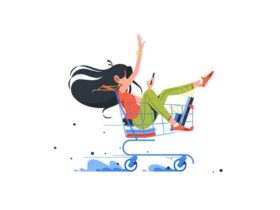To talk about Shopify is to talk about ecommerce.
This platform has earned a place among the tools most used to create online stores.
Present in 175 countries, Shopify technology boasts to have been used in more than 700 thousand existing ecommerces. As if that were not enough, it is estimated that 1.2 million ecommerces used this platform in the past, according to BuiltWith data.
However, launching a store with this ecommerce platform does not guarantee success. In fact, most of it fails miserably.
If you want to know the best design tips for Shopify, you have an appointment with the following lines.
What are the best design tips for Shopify? Discover them!
Have you tried to launch an ecommerce on your own but, oh, isn’t it easy to deal with hosting, web design and so on?
The creators of Shopify (Tobias Lütke, Daniel Weinand and Scott Lake) had this same problem in 2004.
Then they launched Snowdevil, a snowboard product store. They had a lot of problems, but they drew one conclusion: whoever facilitated the creation of ecommerces would be made of gold. And so, two years later they launched Shopify. The rest is history.
If you want to be the next Jeff Bezos or Jack Ma, this selection of design tips for Shopify stores will be very useful to you. What are you waiting for to revolutionize your ecommerce!
Compress images and eliminate useless widgets to speed up loading
There is a clear correlation between the loading speed of an ecommerce and some of its key metrics: bounce rates, conversion rates, cart abandonment rates, etc.
In Shopify as in other similar platforms, reducing loading speed is important. According to several studies, every additional second of load reduces conversions by no less than 7%.
Even without taking into account aspects such as UX, Google better positions in its SERPs those sites that take less time to load. Their search algorithms love fast ecommerces!
It’s not surprising, then, that Amazon, Zappos and other marketplaces take less than 1 second to load. Time is money, isn’t it?
But how to improve the loading speed in Shopify? Let’s look at some of the best practices to achieve this:
- Adapt the dimensions of your images to the size shown. That way, they’ll take up less space. Also, compress them with the help of a specific tool. Their weight can be reduced by up to 50%.
- Install a plugin or widget that allows you to dose the load of images and other elements.
- Eliminate the most useless widgets or that do not contribute anything to the user.E These elements tend to burden loading times. In addition, they have a negative impact on the simplicity of the design of the themes, which is one of the keys to their success.
Use attractive information and photos in your products
Do you think this recommendation is too much? That it’s too obvious? You’d be surprised how many Shopify retailers use bad product chips.
For online consumers, the elements of a product card (information, images, etc.) are of paramount importance.
The customer cannot touch, feel or taste the product. This is why ecommerces are at a disadvantage compared to physical businesses, but this does not have to be an obstacle!
Optimizing product chips helps you improve conversion rates. All you have to do is write and structure the texts carefully, not forgetting the technical data sheet with all its details.
As far as images are concerned, ASOS and other ecommerces don’t just include a gallery with quality photos – they also publish videos on their product sheets!
On the other hand, don’t forget to use functions such as zoom to enhance the experience for your consumers.
You can implement this magnifying glass by installing jQuery Image Zoom, Magic Zoom Plus and other similar apps. Of course, one of the most useful Shopify design tips you can receive.
Show your customers that your ecommerce is secure
Several studies suggest that lack of trust is behind the high abandonment rate of ecommerce shopping carts. Is your ecommerce secure? Well, don’t let your customers think otherwise!
To generate trust in your visitors, you must show certificates, trust seals and other endorsements in visible places.
For example, when making the payment, show them an SSL icon. This way, they will know that payments in your ecommerce are secure. Do the same with eKomi stamps, Trusted Shops, etc.
On the other hand, lack of transparency is also a detrimental factor for online conversions. Don’t hide taxes, shipping costs or other costs. Sometimes including them in the product price is the best option, but there are other alternatives.
Includes a carousel of recommended products
And if you’re still wondering how to make your Shopify store look professional, don’t forget to offer upsells in your product sheets.
We’re talking about related product carousels, which usually appear at the bottom of the cards. The title to use can be ‘Recommended Products’ or ‘You may be interested in buying’.
In addition to providing added value at the UX level, upsells will help you improve your conversions.
Bet on guest checkouts, not forgetting customer registration
Do your customers have to register before making their first purchase? This is a big mistake!
It is best to use guest checkouts. This way, your customers will be able to make one and a thousand purchases, without having to register.
The goal, however, should be to earn your customers’ trust until they become loyal to you, right? That’s why you should include a registration form in your checkouts.
Use general and specific categories
Another of the best design tips for Shopify is to implement menus with general and specific categories.
For example, ‘men’s footwear’ would have a drop-down submenu with ‘moccasins’, ‘sneakers’, etc. Differentiating by gender, age and style is a wise move, as it improves the user experience.
As for colours, brands and other parameters, it is best to use them as filters in product searches or in the categories themselves. For example, in the subcategory ‘moccasins’, these filters would be very useful.
There are countless models of leather and suede, blue, red or white, etc. These filters will help consumers enormously.
In short, these recommendations will help you to design a top quality ecommerce.
Aspects such as user confidence, navigability or professional image have a great influence on the purchase decision. Do you want to reduce your cart abandonment rates and improve conversions? Follow these tips and you will get it!





